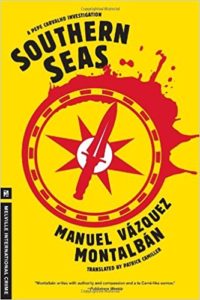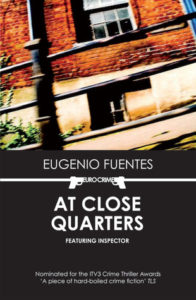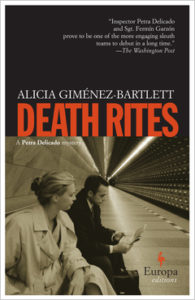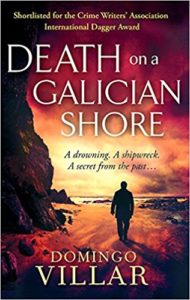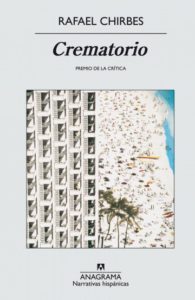Spain is an incredibly beautiful and luminous place. But the more luminous and beautiful a place, the further and darker is its shadow. Every society—Spanish included—has its scars and unhealed wounds, and crime, whether individual or collective, is the symptom of its disease. We Spanish writers are moved by the tragedy of life, compelled the weight of history (the Spanish Civil War in particular), and concerned about political corruption and the effects of the appalling recent economic and social crisis. We provide literary x-rays of a country caught between the issues of modernity and the preservation of traditions immortalized by people like Lorca, Ortega y Gasset and Miguel de Unamuno. Somewhere between the mythical Spanish fury and the desperate romanticism popularized by writers like Hemingway, Malraux, and Dos Passos lies the reality of Spain, a country in turmoil, searching for its identity in the 21st century.
To understand a society deeply, one must read its writers. I offer here a few of the best Spanish crime writers—an unfair and subjective list, to be sure.
Southern Seas (Los Mares del Sur) by Manuel Vázquez Montalbán (1979)
This is Vázquez Montalbán’s most popular novel. With gourmand detective Pepe Carvalho as the protagonist, Southern Seas made journalist and poet Vázquez Montalbán a famous writer in Spain and has been translated into countless languages. The action takes place during Spain’s Transición—the post-Franco transition to democracy—on the eve of Barcelona’s first municipal elections. It paints a harsh picture of a difficult period filled with corruption in the construction sector and violence on the part of the extreme right, particularly in the city’s most marginalized barrios. Vázquez Montalbán realized even in those early days that the young Spanish democracy was not to fulfill Spaniards’ dreams of freedom.
The book opens with the body of Stuart Pedrell, an important entrepreneur, turning up in a marginalized part of town, having been stabbed to death. Pepe Carvalho, our ex-CIA agent protagonist, investigates what the deceased had been up to for the last year of his life and thereby unearths a mess, set to the backdrop of Spain’s generalized sense of frustration. From high society to ghetto underworlds, the novel sketches an intense cast of characters and scenarios that reflect the personal and collective conflicts of Spain during the years of la Transición.
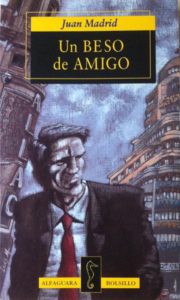
Un beso de amigo (A Friendly Kiss) by Juan Madrid (1980)
Juan Madrid, along with Vázquez Montalbán, González Ledesma, Andreu Martín y García Pavón, is in the royal flush of Spanish noir. Un beso de amigo is the debut of investigator Toni Romano, retired boxer and connoisseur of Madrid crime. The author was a journalist at Cambio 16, the legendary investigative current affairs magazine, and has in-depth knowledge of actual murders and violence committed by the extreme right. He uses his experience to tackle topics including political corruption and terrorism. In this novel, Madrid (the writer) offers a stark and brutally honest portrait of the Madrid (the city) during la Transición—heaving with Francoists-turned-democrats, political abuse, prostitution, and drugs flooding the youth.
Un beso de amigo opens with the search for a young woman, promiscuous for her age, and ends with the search for Otto, a German accused of stealing a number of letters which could compromise the position of an executive who’s involved in shady affairs. Everything is a search: For the lost innocence of others and one’s own. It’s hard-boiled and tender in equal measure.
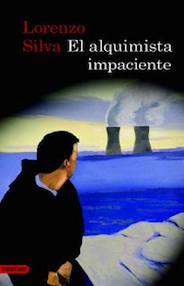
El Alquimista impaciente (The Impatient Alchemist) by Lorenzo Silva (2000)
Lorenzo Silva is an attorney by training and one of the most award-winning writers of the Spanish crime genre. Over the years he’s created one of the most important sagas in Spanish noir, featuring two Civil Guards, a man and a woman, as protagonists of their own adventures. Their success disproves an old stigma that claimed police would never have a place in contemporary Spanish fiction due to their role in Franco’s dictatorship. Silva regularly reads up on actual corruption cases, often using them as inspiration.
The action in this novel begins with a naked corpse found chained to a bed in a sleazy hotel. Sergeant Bevilacqua, our anomalous Civil Guard criminal investigator, and his assistant Chamorro, are charged with solving the crime. The investigation that follows is no mere police inquiry: the pair must delve into the hidden lives of the victim and those around him, unearthing a complicated scheme involving money and diverse interests. And the key, as in alchemy, lies in patience. Written in a very forthright style, this book explores the motives for the murder, not always as obvious as they seem. (Not translated, but turned into a movie.)
At Close Quarters (Cuerpo a cuerpo) by Eugenio Fuentes (2007)
A prestigious military officer commits suicide with his own pistol. But his daughter doesn’t believe he killed himself and hires a detective to investigate the circumstances surrounding his death. This serves as the excuse for the talented author, Fuentes, to dive into a reflection on human nature and the atavistic traumas of the Spanish people. It’s an excellent reflection of the kind of everyday, low-intensity cruelty that marks people’s interactions in deserted places. Eugenio Fuentes is one of Spain’s very best prose writers. Cuerpo a cuerpo is his fourth novel featuring private investigator Ricardo Cupido, who bears no relation to US heroes in either his excesses or his violent surroundings: this is an entirely realistic PI. Cupido spies on a suspect and soon begins to admire her, longs to approach and speak to her. But before he can, a young man named Samuel finds an unpleasant surprise: gory photos in which a dog can be seen mauling a teenager to death. It takes Fuentes very little time to craft a character who leaps from the pages and comes to life.
Death Rites (Ritos de Muerte) by Alicia Giménez Barlett (1996)
The protagonist Petra Delicado was created in the nineties, and at the time was almost unheard of in a society like Spain’s, where roles like detective were not granted to women. Delicado is a police inspector with a desk job in documentation. She’s just gotten divorced for the second time and is in the process of moving to her own place in the suburbs. She’d like to be assigned a case case but, in the meantime, carries out her job with great professionalism. And then a case arrives, unexpectedly. One night the phone rings and her presence is demanded down at the station. Due to short staffing, she’s assigned a rape case and introduced to her partner, Deputy Inspector Fermín Garzón. In this novel, Alicia Giménez takes on male violence, sexual abuse, and sexual discrimination, and does so with a curious sense of irony.
Death On A Galician Shore (La playa de los ahogados) by Domingo Villar (2006)
One of the greatest crime writers, Villar is a fabulous example of spectacular rural crime fiction. His books takes place not in a big cities, but in rural places like northwestern Galicia. One morning, the body of a sailor is washed up on shore. Were it not for the fact that his hands are tied behind his back, Justo Castelo might be one more “son of the sea” who met his death while working the waters. But Inspector Leo Caldas suspects this is not the case. He’s not your straightforward detective: rather, he’s disillusioned, prone to violence, and lives absorbed by his own memories and a profound sense of melancholy. While investigating the death of Castelo, Caldas becomes immersed in the small town’s seafaring environment, attempting to solve the crime amid men and women very reluctant to reveal their suspicions and who, once they do decide to speak, lead the detective in an astonishing direction.
Crematorio (Crematorium) by Rafael Chirbes (2007)
The death of Matías Bertomeu sets in motion Crematorio, a monumental novel about urban corruption. The cast of characters includes Rubén, a real estate developer entirely bereft of scruples; his daughter Silvia, a self-righteous art restorer married to Juan Mullor, an alcoholic writer living out the failure of his final days; Ramón Collado, the builder who did Rubén’s dirty work; Traian, a Russian Mafioso and old associate of Rubén’s; and Mónica, his very young and very beautiful wife. Chirbes here presents readers with a horrifying prospect: corruption as the lifeblood circulating through the body of a society in which destruction of the countryside is a symbol.
Rafael Chirbes outclasses even himself in this astonishing book, more radical, savage and better written than any of his earlier works. No one like him has dared to tackle the political corruption on the Spanish coast that precipitated the worst economic crisis in national history, one we’re still recovering from. Crematorio eschews plot, genre, and mystery, and is sustained by pure language, offering prose as a form of catharsis. The book takes on territory very difficult to decipher: states of mind, frustration, betrayal and indebtedness. It exemplifies the way our particular form of modernity—what we, as Spaniards, imagined we’d become post-Franco—has given rise to a society and system that repress us. Chirbes here reflects on whether our ideals have been fulfilled and what to do about our failures.

Prótesis (Prosthesis) by Andreu Martín (1980)
Miguel Vargas Feinoso observes the reflection of his smile in a crystal glass. He’s got a face full of scars, teeth knocked out, and four years of prison behind him. “El Gallego” is the swine to blame for all this, and Miguel won’t stop until he’s found him and exacted his revenge. Thus opens Prótesis, an iconic novel of “dirty realism” that launched the eighties and a time for which Andreu Martín is one of the most prime and peculiar examples. This novel was one of the first to tackle the relationship between attacker and attacked, each of them victim and executioner of violence, each unable to satisfy their desires through any nonviolent means.
Classic American noir has nothing on Andreu Martín in general, and Prótesis in particular, both in the way he writes action and his incredible, fictional backdrops. His command of the genre is absolute, his narrative style—clearly hardboiled—does not merely describe intrigues but provides a simultaneous critique and analysis of society. He makes continuous references to the prevailing real-life criminal atmosphere of the time, and does so with nuanced authenticity. Marín tackles head-on the savagery and violence perpetuated by the police in the early days of Spain’s democracy, and poses questions that continue to torment us: How long will the wheel of retribution continue to turn? When will we free ourselves of the commitment to violence?

La muerte de los marqueses de Urbina (The Death of the Marquises of Urbina) by Mariano Sánchez Soler (2013)
It’s based on a true crime that stunned Spanish high society. When journalism and historiography cannot provide solutions, fiction becomes the real narrator, interpreting society. Mariano Sánchez Soler, a crime journalist and investigator, here uses literature to recreate this double murder: Fierro specializes in illegal dealings, and is employed by the banking industry. He is charged with masterminding the perfect crime, planned down to the last detail, including the fabrication of a convenient scapegoat.
The murder of the Marquises of Urbina, killed as they slept peacefully in their beds, rocked Spain in 1980, when we were already under the scourge of terrorism during the post-Franco Transición. Despite everything going as intended, Fierro’s plans have unforeseen consequences. From the shadows, higher forces in the money-world are on the move, forces outside his control that could at any time turn him into the one to beat.
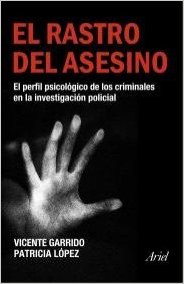
El rastro del asesino (The Trail of the Killer) by Vicente Garrido
Vicente Garrido, a criminologist and author of books including Crímenes exquisitos (Exquisite Crimes), here charts a course through the dark side of humanity: unresolved murders that have continued to stump the Spanish justice system. In this book, he dives into the mindset and actions of serial killers and chronicles the early days of forensic science and the methods used by investigators to stop criminals. Within its pages readers will find infamous names including Alfredo Galán Sotillo (“The Playing Card Killer”), Juan José Pérez Rangel (“The Putxet Killer”), David Berkowitz (“Son of Sam”), and Ricardo Ramírez (“The Night Prowler”). Each of them forms part of our national panorama of the most horrific murders with the greatest repercussions on Spanish society in recent years.


